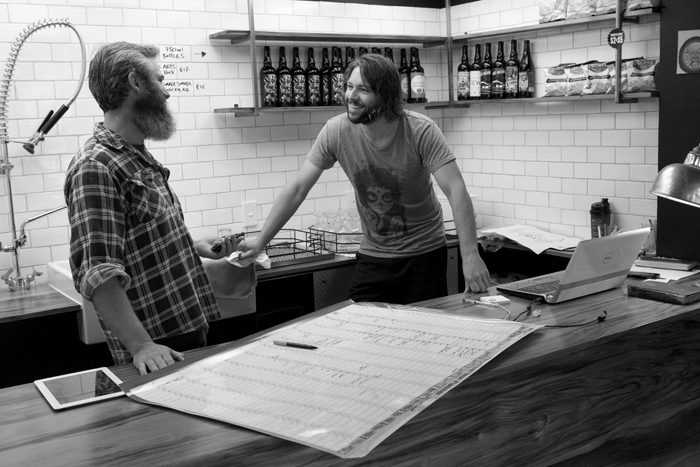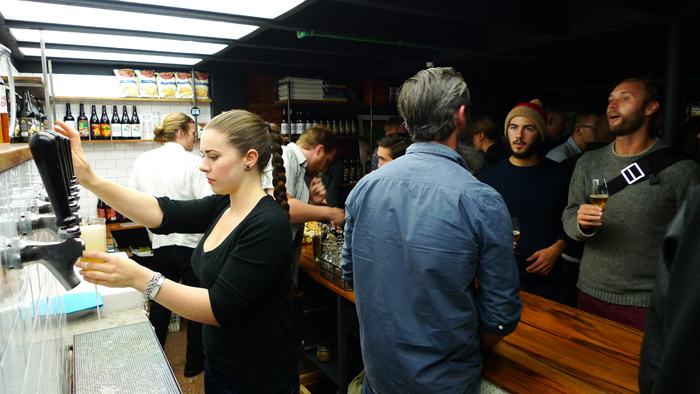how ‘stupidly small’ became insanely good
Garage Project in Wellington, New Zealand is one of the most exciting new craft breweries in the world. Anyone who thinks brewing innovation might be slowing should try some of the creative brews they are producing. These aren’t just gimmicks with exotic ingredients either. They are incredibly tasty beers that can compare with some of the best out there.
Despite having started as late as 2011, Garage Project has expanded quickly and garnered considerable respect, both in New Zealand and overseas. Brothers Pete and Ian Gillespie together with Jos Ruffell launched the bold endeavor. Sure, they produce some standards like IPAs, a stout and a pilsner. But then they deliver a lager brewed with smoked chipotle chili, raw cocoa nibs, vanilla and agave; a dark ale with coffee and chicory root; or a red amber with toasted coconut, golden syrup and oats… the list goes on.
They owe some of their inspiration to Spanish chef Ferran Adrià. As Ruffell explains it, “He’s one of the greatest chefs of the last hundred years. He is phenomenally talented, progressive and experimental. He’s constantly changing menus and developing new techniques. We had this theory that breweries don’t actually set themselves up in a way so that they can try new ideas like this. They can’t do new things very often and get stuck in their ways. We wanted to be different. We decided that the path to being different was starting stupidly small. We made a conscious decision to buy SABCO’s Brew Magic system that a lot of home brewers use. We knew that we wouldn’t make any money at first. It was the only way we could think of that excited us. We didn’t have to wait, we didn’t have to go cap in hand to the bank–we could just start.”
Naturally, a close history between these three gentlemen preceded their plans. Ruffell and Ian Gillespie were born just a few houses apart and have been lifelong friends. Pete eventually pursued a career in brewing that took him to England and then Australia. There, he tried to start his own brewery but smashed headlong into a wall of bureaucracy. Ruffell, meanwhile, had been traveling to America for work and had fallen in love with craft beer. Ian, it seems, helped spark the conversation between the two about launching the brewery in Wellington. In terms of bars and consumption, the city is the craft beer capital of New Zealand, but it lacked an actual brewery. Getting approval for one turned out to be surprisingly simple–to Pete at the very least.
At the beginning of 2011, Pete sold his house, quit his job and moved back to New Zealand with his family. Ruffell, who had been reading whatever brewing literature he could find, noted, “After that it was very fucking real! You’ve got your best friend’s older brother with no income, no job. And all the talk that you’d been doing–you’re really doing it now.”
With limited money from their savings, they moved the system into Ian’s garage and began referring to it as the “garage project.” Shortly thereafter, they found an old gas station in the city that they negotiated an affordable rent on. They spent a couple of months cleaning it up before getting permits to run a brewery there. Ruffell describes their original set-up like a pantry where they were chefs who could go in each day to select from a wide variety of malts, yeast and hops.
Pete then came up with their first ‘cooking’ challenge: they were going to brew twenty-four different beers over twenty-four weeks. And that’s how Garage Project launched in January of 2011.
They debuted at a festival and were at the center of considerable excitement. The next few weeks were like a freight train roaring down the tracks. Once they had committed to the twenty-four beers, there was no stopping it and no trial batches. The first two of those twenty-four they actually still brew, as well as a handful of others. A few, which customers disliked, got retired. They catalogued customer feedback (written on the back of coasters), which partially helped them decide what to keep.
In its first year, Garage Project produced roughly fifty beers, with Pete handling the brewing. Ruffell was bringing ideas to the table and helping out anywhere there was a need in the brewery.
“I would research hops, yeast, different brewing techniques and approaches,” explains Ruffell. “Pete would then put his spin on it. He’s a very talented brewer and a very good cook. We brew a huge amount of beers with spices and adjuncts. Of all the brewers in Australia and New Zealand, I would say he was probably brewing the most in terms of different kinds of beers. And the more he brewed, the better he got. Think about chefs in the top restaurants; they are in there every day working their asses off. At most breweries, the brewers are sitting there a lot of the time and not brewing as much.”
If they had failed, they could have retreated with much less financial risk due to the small system. By now, though, they were confident. Ruffell had also gotten the word out about their project and people were keen to be a part of it.
Ruffell jokes, “If you want to do something, tell a lot of people; even if you are scared, it will make you do it.” But then, more seriously, he continues, “Well, I had been telling a lot of people that we were going to be opening a brewery. One of those guys suggested taking on some investment money rather than go to the banks.”
That same person offered them money–much more than they had expected–despite originally telling them opening a brewery was a bad idea. It appears their excitement became infectious and he changed his mind. Private investment was just as well for the Garage Project founders, too, because they had always intended to build a team. Through their new investor’s introductions, they found other partners. In May of 2012, using their pooled money, they were finally able to upgrade to a 10-barrel system from Premier with six twenty-barrel fermenters.
The timing was good, too, because the brewery had just won an award at the Australian International Beer Awards for a collaboration brew with Nøgne in Norway. Awareness of their beers was spreading rapidly. Still, the team continued brewing much as they had been, introducing all kinds of new beers and quickly running out.
When Ruffell describes their method for designing new beers, he returns to chef Adrià, “He was about creating new techniques. If you pioneer a technique, you can apply it to multiple recipes. So instead of a new beer with different hops and ingredients, I asked, ‘What’s a new technique?’”
The result of one of these lines of inquiry was something that would titillate any hop-head: #IPA (pronounced “hash IPA”).
Ruffell explains, “At a kitchen, chefs do all kinds of prep work before they actually serve the food. I thought about prepping our ingredients. Hops are an obvious one to start with. You want the essential oils and acids. I started researching it and discovered a method where chemists could isolate pure lupulin glands. I did that and it’s basically the same method for making hash (the marijuana product). You take whole hops and agitate them in liquid nitrogen, which breaks them apart, but you’re not heating it so the delicate flavors remain intact. Then you press that through a series of ever-fine filters and you’re left at the end with pure lupulin glands. We used that to make our #IPA. It allowed us to put a stupid amount of hops into the beer. Normally, you wouldn’t be able to put that much vegetable matter into a beer. The flavor was really intense, but had a kind of delicacy to the bitterness as well.”
Another of their creations they served at the Firestone Walker Invitational Beer Festival, an elite affair with some of the world’s best breweries. It was a beer called Umami Monster brewed to showcase umami flavor through the use of an enormous amount of kombu (kelp) and katsuobushi (bonito). According to Ruffell, members of Yo-Ho Brewing (makers of Yona Yona Ale) were at the festival raving over the beer. Yo-Ho Brewing, incidentally, also released a beer with katsuobushi to accentuate umami flavor called “Sorry”. That white IPA is an interesting contrast to Garage Project’s darker, maltier and richer brew.
Garage Project’s current facility now features a twenty-barrel brewing system and more tanks. They also purchased a canning line, becoming the first craft brewery in New Zealand to do cans. For much of this year, the brewery has been running at capacity and they are already looking at options for another facility. But will their philosophy of constantly experimenting change as they grow bigger? Almost certainly not.
Ruffell returns once again to food, “A kaiseki master chef once said, ‘Being innovative respects tradition.’ You hear this bullshit in the brewing world that, well, this is the way we’ve been doing things since the 1800s. The reality is that brewers were constantly innovating. It was only in the decades from the 1950s to the 1980s that we stopped. Kaiseki as a cooking discipline is incredibly traditional and ornate, but as this guy was saying, all the chefs before him had been introducing changes. So if you say you’re going to do it how it’s always been done, you’re not respecting the tradition.”
This article was published in Japan Beer Times # () and is among the limited content available online. Order your copy through our online shop or download the digital version from the iTunes store to access the full contents of this issue.






